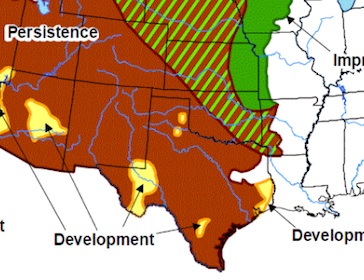The latest news this week about Texas’ continuing drought was more of the same – and potentially worse.
The latest U.S. Drought Monitor report, produced by a university-government partnership, was released Tuesday, showing that the great majority of Texas is still experiencing some degree of drought conditions, ranging from “moderate” to “exceptional” (the driest category).
Almost all of the part of the state that wasn’t officially deemed to be in a drought this week was still classed as “abnormally dry.”
An updated Seasonal Drought Outlook, issued Thursday by the Climate Prediction Center of the National Weather Service, offered a similar picture for the period running through June.
Most of the state, the center said, is expected to experience persistent or intensifying drought conditions, with drought expected to develop in most of the area where it isn’t already occurring.
This forecast was in line with a trend that the Drought Monitor noted for the past 30 to 60 days with lower-than-normal rainfall in East Texas – “an expansion of abnormal dryness and moderate drought.”
Anyone hoping that such predictions could prove wrong and a return to more normal precipitation might be in the offing would not find any encouragement in a bleak blog post on Monday by the Texas state climatologist, Texas A&M University’s John Nielsen-Gammon.
Nielsen-Gammon noted that apart from East Texas, “most of the rest of the state is in its third year of drought (and counting).”
He included a chart with lines showing five trend lines – one for a year with “normal” precipitation and one showing the precipitation for each of the last four “water years,” defined as October through September – 2009-10, 2010-11, 2011-12 and the current 2012-13.
Texas’ period of record-breaking heat and drought in 2010-11 was the lowest line on the chart, with notably less precipitation than the lines for a normal year and for both 2009-10 and 2011-12.
The portion of the 2012-13 year that has elapsed so far – October through March (including Nielsen-Gammon’s estimate for the remainder of the month) – had a line that very closely tracked precipitation in the record-dry 2010-11.
“Since it’s planting season already, this third year of drought is already guaranteed to cause some agricultural loss,” Nielsen-Gammon observed. “However, the biggest news is water supplies.”
He provided another chart that showed statewide reservoir levels this year had started well below where they were in 2011 and by mid-March were only slightly higher – about 65 percent full.
As a result, reservoir levels are breaking records every day. Indeed, reservoir levels are already as low as in August 2011. Water supply issues will potentially be very important with this drought. … Since April-September of 2012 was near normal, we can use the data from 2012 to predict the 2013 water levels.
That prediction, shown on yet another chart, has reservoir levels declining to near 50 percent, as a statewide average, by early September.
Many places, probably in eastern Texas, will still have plenty of water available from reservoirs, but other places, mostly in central and West Texas, will do much worse. Current hotspots are the Rio Grande along the border with Mexico and north-central Texas west of Fort Worth.
If the drought continues as I have depicted it, [by] the end of the summer it will be the second-worst drought on record, behind only the drought of the 1950s.
Cities are warily preparing for such an eventuality, as recent news reports indicated.
The San Antonio Express-News last week reported that city’s tightest-ever water-use restrictions are possible within just a few weeks.
As early as May, the San Antonio Water System could go to Stage 3 outdoor water restrictions, the first time ever, as a result of the region’s longest continuous drought in decades.
Watering would be allowed only once every other week under Stage 3, instead of once a week as it is now in Stage 2.
And if weather projections for the next several months are accurate, restrictions will only get worse.
The region is now in the third consecutive year of drought — a level of parchedness that has only happened two other times since the 1950s. The last three-year drought was in the 1980s.
Stage 2 restrictions started almost a year ago, and the area teetered on the edge of Stage 3 last year, but somewhat increased rainfall in the later third of the year helped to avert it.
On Thursday, meanwhile, the Texas Tribune reported that Wichita Falls, with more than 100,000 residents, had been included on state officials’ list of communities, most with far fewer inhabitants, that might run out of water in 180 days.
Wichita Falls was added to the list last month when lake levels dropped to 40 percent and the city entered Stage 3 watering restrictions. Currently, residents can water only once per week, and city officials warn that the restrictions could tighten further sometime this summer.
At the end of the year, some projections indicate that the city “would not be able to pull any more water” from reservoirs, said Daniel Nix, operations manager for Wichita Falls public utilities. Nix said the utilities’ projections do not show that the city will run out of water in the 180 days – most projections do not put them at zero water until some time next year. But Nix doesn’t mind the 180-day designation, as it will help speed up the process of implementing planned conservation efforts.
– Bill Dawson
Image credit: National Weather Service

